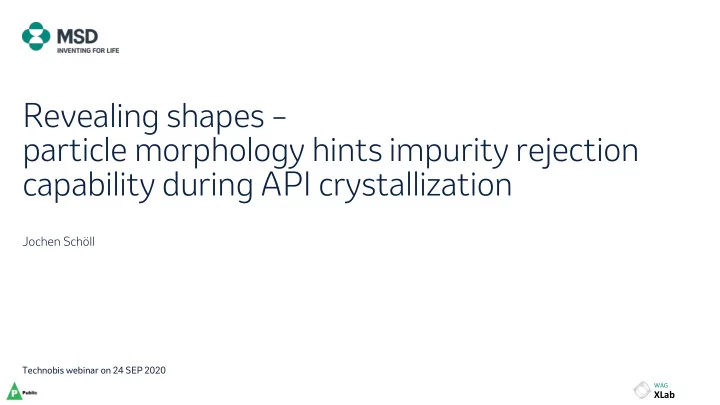

Revealing shapes – particle morphology hints impurity rejection capability during API crystallization Jochen Schöll Technobis webinar on 24 SEP 2020 WAG XLab
MSD Werthenstein BioPharma in Schachen Lucerne
“ Medicine is for the people. It is not for the profits.” George W. Merck (1950) 3
Main tasks in pharma crystallization Process: • Solvent system • Temperature • Addition rates • etc … 4
Typical development challenge: limited amount of API and 3 ways to make most out of it: Data-rich Miniaturization Parallelization experimentation 5
Approaches in our lab Data-rich Miniaturization Parallelization experimentation 6
Crystallization issues during 1 st GMP delivery (1.5 kg API) Solvent switch crystallization • Quantiles [ µ m] (EtOAC → Toluene) successfully x 10 40.2 rejected impurities but failed x 50 78.0 controlling solid form x 90 152.6 Additional recrystallization from • MeOH/Water was needed to Unmilled API control the crystal form Final micronization step via • Quantiles [ µ m] spiral jet milling yielded 1.5 kg x 10 1.4 API x 50 4.1 x 90 8.1 Jet-milled API 7
Solvent (pre-)selection with HT data Average [mg/ml] Average [mg/ml] Average [mg/ml] Solvent Selection Solvent Selection Solvent Selection High-throughput solubility • Acetone 90.14 50:50 EtOH:H2O 0.46 2:1 DMF:H2O 8.24 50.41 0.06 1.10 MeCN 25:75 EtOH:H2O 1:1 DMF:H2O data provides a first set of EtOH 8:1 EtOH:H2O 1:1 DMF:MeOH 9.87 10.20 > 100 H2O 0.00 2:1 EtOH:H2O 3.33 2:1 DMAc:H2O 9.06 potential solvent systems: Toluene 3.87 95:5 IPA:H2O 9.45 1:1 DMAc:H2O 0.91 THF >100 90:10 IPA:H2O 10.27 2:1 NMP:H2O 16.93 0.00 9.01 1.38 Heptane 80:20 IPA:H2O 1:1 NMP:H2O ➢ Good solvents IPAc 50:50 IPA:H2O 0.12 1:1 Toluene:MeOH 52.46 22.46 DMF >100 25:75 IPA:H2O 0.15 1:1 Toluene:MeCN 73.57 NMP >100 2:1 IPA:H2O 4.75 1:1 Toluene:EtOH 31.25 MeOH 17.95 8:1 IPA:H2O 10.61 1:1 Toluene:IPA 22.83 2-methylTHF 60.72 95:5 THF:H2O >100 1:1 IPAc:MeOH 37.36 ➢ Good antisolvents DCM 90:10 THF:H2O 1:1 MeCN:EtOH 49.77 >100 54.20 >100 >100 1.40 DMAc 80:20 THF:H2O 1:1 2-methylTHF:Heptane DMSO >100 50:50 THF:H2O 0.69 1:1 THF:MTBE 32.77 EtOAc 49.83 25:75 THF:H2O 0.09 1:1 Toluene:MTBE 5.50 ➢ Risky systems IPA 5.90 2:1 THF:H2O 36.07 1:1 IPAc:MTBE 13.46 MTBE 3.58 8:1 THF:H2O >100 1:1 IPA:MTBE 7.86 2-butanol 4.59 90:10 Acetone:H2O >100 2:1 Acetone:Water 60.48 MEtOAc 80:20 Acetone:H2O 1:1 Acetone:Water 76.10 0.11 15.85 n-propanol 6.85 50:50 Acetone:H2O 0.07 1:1 EtOH:Heptane 8.32 Hexane 0.00 25:75 Acetone:H2O 0.07 1:1 THF:Heptane 2.85 90:10 MeCN:H2O 68.43 2:1 Acetone:H2O 0.08 2:1 THF:Heptane 0.30 80:20 MeCN:H2O 45.79 8:1 Acetone:H2O 49.13 9:1 THF:Heptane 81.30 50:50 MeCN:H2O 95:5 MeOH:H2O 1:1 IPA:Heptane 0.84 10.17 3.63 0.08 8.75 0.37 25:75 MeCN:H2O 90:10 MeOH:H2O 1:1 Toluene:Heptane 95:5 EtOH:H2O 50:50 MeOH:H2O 2:1 IPAc:Heptane 11.79 0.17 7.81 90:10 EtOH:H2O 11.59 2:1 MeOH:H2O 0.98 1:1 IPAc:Heptane 3.01 80:20 EtOH:H2O 7.50 8:1 MeOH:H2O 8.74 1:1 MTBE:Heptane 0.22 1:1 DCM:Heptane 0.00 8
API with two known forms Both, polar and apolar solvent • systems successfully generated the desired Form 2 at lab scale Seeded process with • Form 2 supersaturation control expected to yield desired form EtOAc/Heptane MeCN/Water Form 1 9
First results at 300 mg scale Particle morphoplogy changes in different solvents – potential for different impurity rejection? • Apolar solvent systems Polar solvent system EtOAc/Heptane IPAc/Heptane MeCN/Water 10
Crystallization and impurities in the literature Dichloromethane Ethanol 11
Development work for 2 nd GMP delivery Apolar solvent systems Polar solvent system EtOAc/Heptane 2-MeTHF/Heptane MeCN/Water EtOAc/Heptane 2MeTHF/Heptane MeCN/Water API purity 99.9% LCAP 99.9% LCAP <99.0% LCAP Form control X ✓ ✓ Color rejection insufficient insufficient insufficient 12
Data-rich experiment at 3 g scale – EtOAc/Heptane Yield ≈ 96 % Vol. prod. ≈ 62 g/L Cycle time ≈ 18 h Form impurity (rods) Temperature 13
Crust formation Hot reactor walls induce Cool reactor walls avoid “creeping”, “creeping”: but still on probes & stirrer: 14
Activated carbon treatment & rex in 2MeTHF/Heptane Crude API Pure API Crystallization + Activated carbon 15
Successful 2 nd GMP delivery (27 kg API) Improved chemistry reduced RM • Quantiles [ µ m] cost by 40x x 10 1.4 New API crystallization process • x 50 4.1 Eliminates the need for recrystallization • x 90 8.1 due to improved impurity rejection Ensures robust API form control (lower • seed mass was compensated by extended seed age) Rejects color using AC • Delivered 27 kg API with a higher • crystallization yield of +13% Jet-milled API 16
Potential to eliminate jet milling? Unseeded high-shear • reverse additions have been performed in MeCN/Water and EtOAc/Heptane API crystallization process Polar and apolar systems • yielded mix of forms Ongoing work with • seeded reverse addition 17
Summary • Different particle morphologies can indicate impurity rejection differences (lower aspect ratio correlates with higher purity) • Combination of miniaturization and data-rich experiments allowed for an optimized process design regarding impurity rejection, form control, de-coloring, and process yield • Further work on bottom-up process with form control ongoing Thank you! 18
Q&A Acknowledgements - Erica Schwalm - Eric Ashley - Eric Sirota - Siwei Zhang - Yonggang Chen
Recommend
More recommend